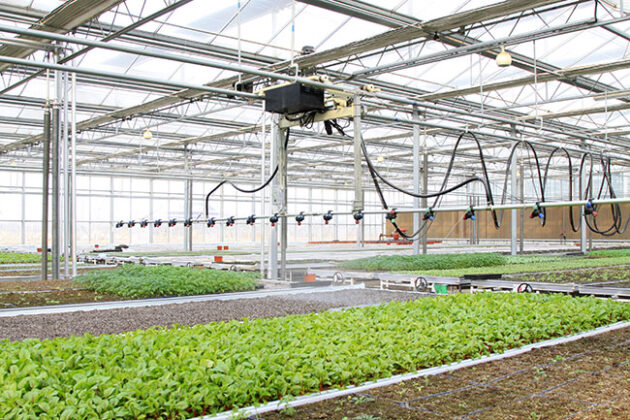
Features
Business
Getting ready for your financial future
Amid a rapidly changing economic environment, knowing your options will help you stay agile.
December 6, 2021 By Sandra Eedy
 Interest rates, the fluctuating Canadian dollar, and changes to the economy can all impact your business. Know your options ahead of time.
Photo credit: Andrey Popov / ADOBE STOCK
Interest rates, the fluctuating Canadian dollar, and changes to the economy can all impact your business. Know your options ahead of time.
Photo credit: Andrey Popov / ADOBE STOCK Like many industries, COVID-19 has taken its toll on greenhouse farming. But with strategic planning, it’s not too late to get a good thing growing! Anticipating a year of recovery, greenhouse farmers need to make smart decisions to respond to the many factors impacting the industry.
Although there’s no crystal ball to foresee how these factors will play out, knowing your options can help you make the right decisions for your business. Drawing on my own experience working with clients in agriculture, I have gained valuable insight on some of these factors and how greenhouse producers can respond to ensure agility and longevity in today’s market.
The Importance of Debt Restructuring
Moving into the winter months, practising proper debt control is a must. Farm debt restructuring can come in a variety of forms. The first step is to get in contact with an agricultural lender who’s familiar with your industry and takes the time to understand your specific operation. They will find the best options to suit your needs.
Some of these options might include payment adjustments, cutting expenses, extending loans, interest rate or term adjustments and assistance in reading the fine print. As farming is a volatile industry, being proactive about your finances will ensure you’re able to weather the storm.
When it comes to cutting expenses, focus on the ones you have control over, like personal withdrawals, and limit them to the amount you require each month for living. When looking at cutting variable costs, such as fuel and crop inputs, consider using pre-fixed payments when pricing is low.
If you need to substantially cut costs, review your financing and take advantage of low interest rates. By refinancing your debt structure through consolidation and spreading the debt out over a longer period of time, you can lower your monthly payment. Keep in mind, while this lowers your interest expense in the short term, it increases the cost of borrowing over time. This approach can also impact future years’ cash flow, which may have been used for inputs into the farming operation, and is another great reason to speak to an agricultural lender who understands your market.
Getting Started and Exploring Niche Markets
New greenhouse farmers and those looking to expand into niche markets must consider a variety of key points. Where will you market your product? Do you have signed contracts? How viable is your plan in the face of shifting consumer demand?
When meeting with your lender to secure financing, come prepared to answer these questions. Targeting the right markets to sell your product will lead to net income with the proper cost margins in place, ultimately guaranteeing the financial health of your business.
Effects of Interest Rate on Greenhouse Farming
Interest rates in 2021 have stayed constant and low. While it’s too early to predict whether rates will stay this way, in the event they do it will be much more affordable for greenhouse operators to buy, build and sell at a favourable dollar value. Alternatively, if interest rates rise, this would increase the cost of borrowing, cost of construction and would ultimately lower the sale value of real estate. It can also put considerable pressure on debt servicing, causing increased interest payments with less being applied to principal reduction.
When interest rates begin to fall, the normal reaction is to stay short on term and wait for the falling to slow. From there, you can fix down your rate of interest. As for rising rates, fix down before they increase too much.
The fluctuating Canadian dollar plays a role in sales projections as well. If the Canadian dollar remains where it is now, the United States (US) will be able to purchase our commodities at a much lower dollar rate. Alternatively, a rising Canadian dollar could hurt the sale of produce into the US due to the increase in cost from conversion to the Canadian dollar.
Is Automation the Way to Go?
Integrating the right kind of technology can enable new opportunities for growers, with autonomous equipment poised to assist growers in achieving better, more consistent quality to obtain higher prices at market. The pandemic has also introduced uncertainty into the labour market, which automation can help streamline.
For growers interested in pursuing automation, consider affordability. Some of the ways a producer can determine affordability is through evaluating their financial statements and debt servicing capacity. Technology can be very expensive and the cost for borrowing is contingent on what the cost of the equipment works out to be. Getting in touch with your lender will help assess these key factors to determine if this is the right investment for your business.
Growers should keep in mind there are many aspects that can affect the affordability of the capital equipment purchases. One of the main factors is loss of crop from weather, disease or insects, which a producer can protect against by taking out crop insurance through the government programs. The cropping business needs to have the ability to produce large volumes of product to generate higher gross sales in order to pay for the technology.
When considering if it’s the right time to buy, first ask yourself if the purchase is vital for your operation. If it is, by what percentage will your crop production increase? This increased cash flow assists with the repayment of the capital equipment purchases, which are normally financed out over a term of five to seven years with monthly or semi-annual payments.

Instead of cutting back on expenses for essential supplies, consider saving on capital costs such as by choosing used equipment over new. Photo credit: YuanGeng / ADOBE STOCK
A Fine Line to Cutting Expenses
Reducing expenses isn’t always a fix and can actually lead to complications. Working with agricultural clients, we simply do not recommend cutting expenses when it comes to seed, fertilizer and pesticides. One needs to grow strong, healthy plants to get strong production. Instead, when making capital purchases, consider cost cutting in the form of used equipment over new. Some will say “but I’ll have repairs,” which is true, but those can be made in your own shop versus the dealer, further reducing the labour cost on equipment.
There is also benefit in volume purchasing and working with signed contracts to determine purchase quantities and informed planning. Cutting expenses is not about trying to reduce all costs, but rather making informed decisions in certain areas for the best choice for your business.
Increased Access to Markets and Resumption of Demand
So long as the food services industry remains open, the demand for fresh vegetables will continue to increase as more and more Canadians head out to eat. To prepare for this shift, consider marketing as a larger group with other farmers. By working together, cooperative marketing is an opportunity for farmers to increase their market share. Through this type of collaboration, individual farmers can access larger markets for better sales opportunities and meet institutional purchasing requirements. Combining labour and distribution resources also helps save the individual costs of fuel and hiring workers.
For co-op marketing to be beneficial, pool your resources for volume sales to buyers or distributors with a minimum five or six neighbouring family operations. Smaller growers can take advantage of the partnerships by selling greater volumes of product, increasing their higher sale price and reducing shipping costs.
In Conclusion, Agility is Key
Greenhouse farmers face a multitude of factors that can dictate the best position for response. While farmers can respond more readily to certain factors such as increased demand, others, like capital purchases, require more planning. Getting in touch with an agricultural lender will help you plan, prepare and evaluate the best path forward to ensure you receive the support and expertise needed for the unique challenges greenhouse farmers face.
Sandra Eedy is the manager of agricultural and small business lending at Your Neighbourhood Credit Union and owner of Eedy Farms with husband, Robert, in Huron County, Ontario.
Print this page